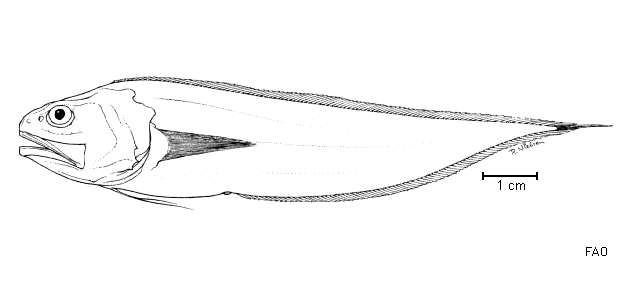| Ophidiidae (Cusk-eels), subfamily: Neobythitinae |
| 29.9 cm SL (male/unsexed) |
|
benthopelagic; marine; depth range 200 - 500 m |
| Indo-West Pacific: off East Africa to New Caledonia. |
|
Dorsal soft rays (total): 63-92; Anal soft rays: 54-79; Vertebrae: 47-49. A deep bodied cusk eel distinguished by the following characters: head 3.0-3.9 times in SL; eye diameter 5.5-6.8 in HL; interorbital 4.8-6.3 in HL; snout 3.8-5.2 in HL; depth 4.3-6.8 in SL; predorsal length 3.3-4.7 in SL, with distance between pelvic origin to anal origin 2.5-4.4 in SL; absence of pseudobranchiae; pyloric caeca 12-13; median basibranchial tooth patches 2; one opercular spine and 3 short blunt spines at the lower angle of preopercle; differs from its congeners in origin of dorsal fin which is above preopercle, no pseudobranchial filaments, pectoral fins and pelvic fins are short and not reaching anus (Ref. 124036) |
| A benthic species found on the continental slope (Ref. 75154). Uncommon species (Ref. 34024). Oviparous, with oval pelagic eggs floating in a gelatinous mass (Ref. 205). |
|
Least Concern (LC); Date assessed: 04 February 2009 Ref. (130435)
|
| harmless |
Source and more info: www.fishbase.org. For personal, classroom, and other internal use only. Not for publication.

